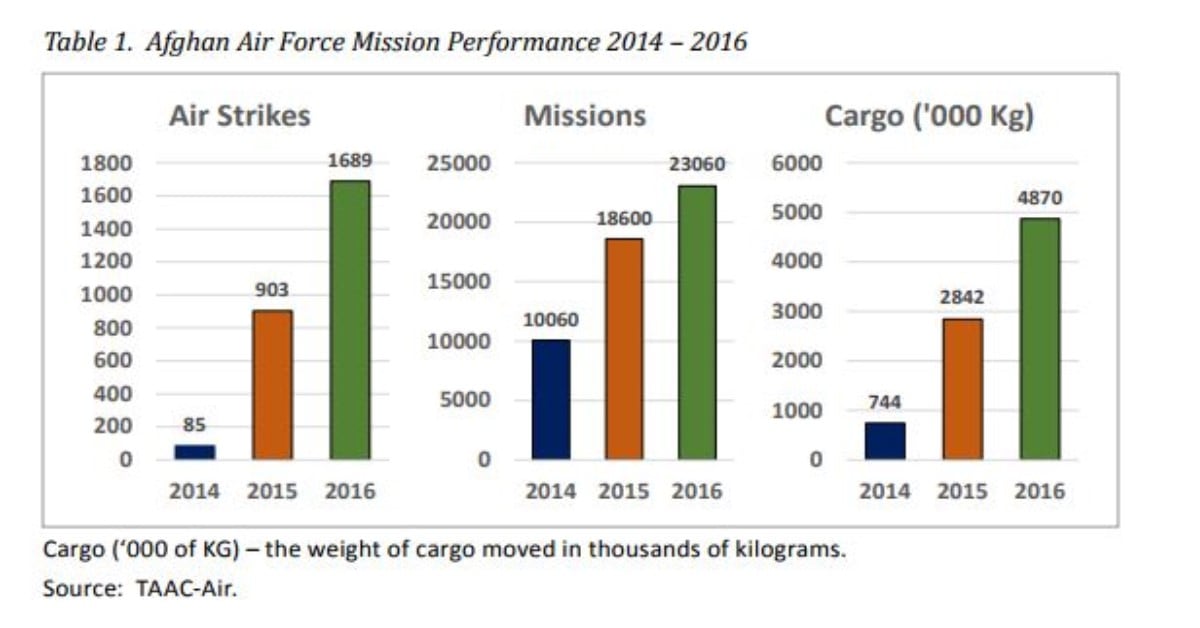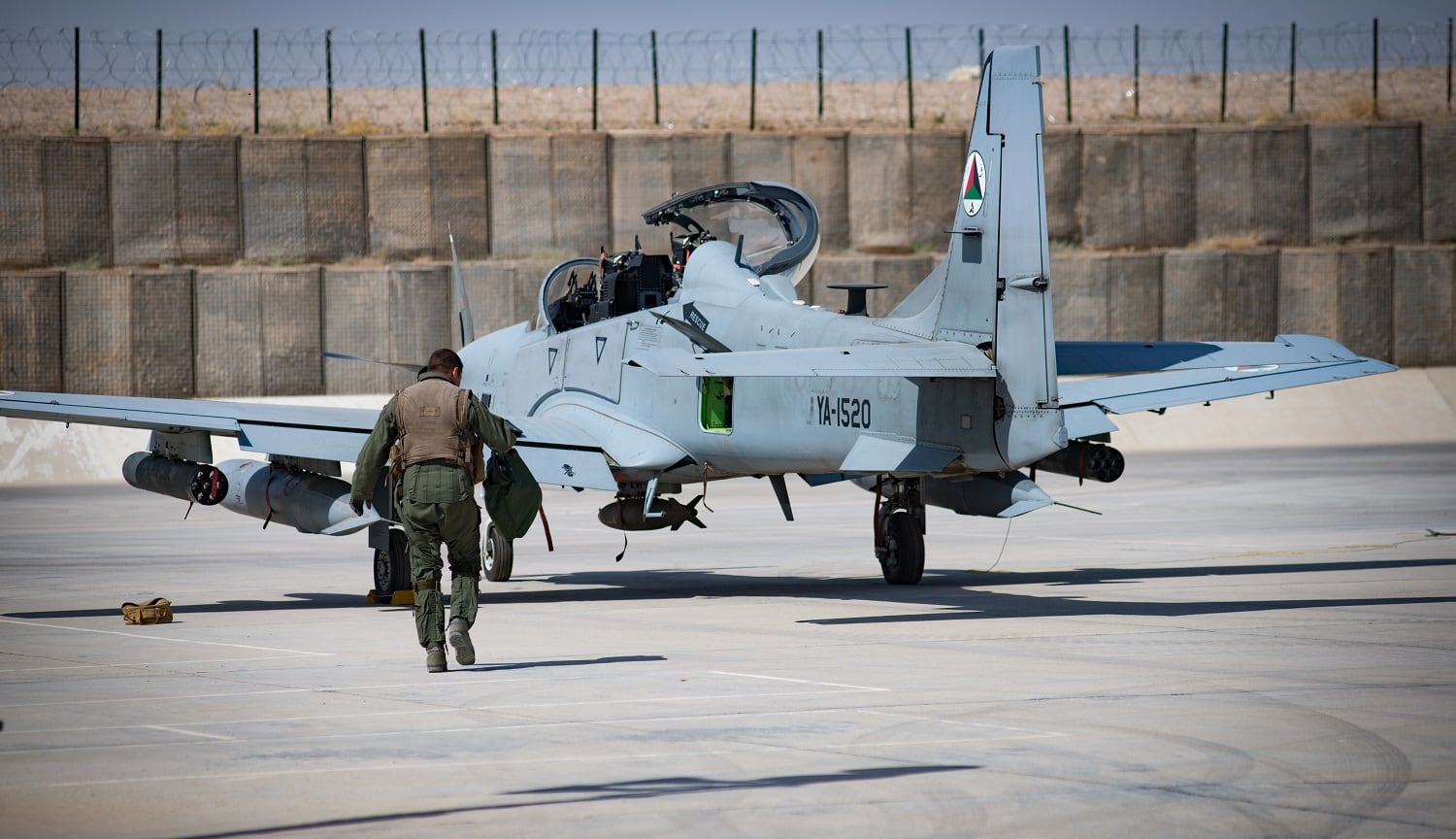Less than two years after flying its first combat mission, the Afghan Air Force’s A-29 Super Tucano aircraft are playing a key role in supporting Afghan soldiers on the ground.
“When they show up overhead, the Afghan National Army have the confidence to continue attacking on ground,” the deputy commander for Train, Advise and Assist Command-South said in a new Defense Department Inspector General report.
Absent sufficient air coverage, Afghan security forces who had grown reliant on coalition air power suffered a series of defeats to the Taliban. Building a native air strike capability within the Afghan Air Force is the key to Afghan success in the future, Army Gen. John Nicholson, the top U.S. commander in Afghanistan, testified before the Senate Armed Services Committee in February 2017.
“Close air support and aerial mobility are the most critical remaining gaps that need to be addressed,” Nicholson said. “At the tactical level, the [Afghan National Army] needs to improve its integration of fires and air power.”
In its report, the DoD IG praised the Afghan Air Force for the progress it has made.
The Afghans’ Super Tucano flew its first combat mission in April 2016. By March 2017, a U.S. brigadier general advising Afghan forces said he had seen a tenfold increase in support to his partner forces from A-29s over the past three months compared to the previous three months, according to the report.
The DoD IG states that the success of the Afghan Air Force’s new light attack aircraft isn’t only measured by the amount of ordnance dropped, but also by how often they pull off target without engaging at all.
“Afghan A‑29 pilots aborted 18 percent of their attacks against identified targets due to concerns about civilian casualties, fratricide, or target identification,” according to data from April 14 through Dec. 31, 2016, provided by the commanding general of NATO Air Command-Afghanistan.
The chief of staff and the director of operations for Resolute Support both lauded the Afghan pilots’ discretion, commenting that the Afghans deserve more credit for their discipline.
The director of operations even opined in the report that “the Afghan A‑29 pilots would likely not receive credit for this good-news story.”

Part of the increased effectiveness of the Afghan Air Force has been attributed to the development of a cohort of Afghan Tactical Air Coordinators, who use small ScanEagle drones to pick out targets and call in airstrikes from forward locations.
An air adviser to the Afghan National Army’s 205th Corps said “ATACs are good at identifying target sets and very considerate of civilian casualties,” according to the DoD IG report.
Although the Afghan air controllers training program was started a couple years ago, its graduates only recently began participating in combat operations in Helmand, Marine Maj. Kendra Motz, a spokeswoman for Task Force Southwest, previously told Military Times.
During recent operations against Taliban-held portions of Helmand province, ATACs integrated into Afghan National Army infantry units and showcased their newfound capabilities, according to Marine Capt. Robert Walters, an adviser with Task Force Southwest.
“Having a competent, capable Afghan Air Force is going to pay great dividends for the ANA,” Walters said in a news release.
“This capability is new,” said Walters. “[But] with where they stand right now, we’re confident they’re going to be able to support friendly forces and provide the same capability we saw in the most recent operations.”
During the 2017 fighting season, a period of time bracketed by the country’s winter months, the Afghan Air Force A-29 inventory increased from eight to 12 aircraft in country, according to a news release from the 438th Air Expeditionary Wing. An additional seven A-29s remained at Moody Air Force Base, Georgia, where pilots receive training.
“We are helping the peace process,” an Afghan A-29 pilot, who could not be identified for security reasons, said in the release. “When an A-29 is overhead, it gives motivation to the ground troops, and the enemy realizes they can be struck anywhere and will feel the pressure to come to the peace table. This is how we will bring peace and stability to Afghanistan.”
The DoD IG report also highlights an increased night vision capability among three of the country’s five pilot and aircrew communities, allowing the pilots to take advantage of the dark hours when Taliban have traditionally been vulnerable.
Kyle Rempfer was an editor and reporter who has covered combat operations, criminal cases, foreign military assistance and training accidents. Before entering journalism, Kyle served in U.S. Air Force Special Tactics and deployed in 2014 to Paktika Province, Afghanistan, and Baghdad, Iraq.





